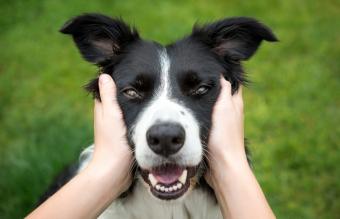The African dotty dog , sometimes call the African hunt wiener or the African paint dog , may be a species you ’re not very conversant with . This multi - coloured dog is a enthralling animate being with unique conduct .
The Oldest Dog
While African angry dogs are theoldest memberof the canid family , they are not closely related to to domesticated dog . African violent click and regular dogs can not interbreed . African barbarian Canis familiaris also differ from naturalise blackguard due to theirlarge litter size , which can have about 10 puppy on average .
Physical Characteristics
Typically , African groundless dogsweigh between 40 and 79 pounds ; they ’re about the size of a medium tolarge domestic frump . Their front paw only have four toe , whereas domestic dogs have a fifth toe , bang as a dewclaw . They also have large round ears for an enhanced audience power , particularly during hunts or for obtain other pack members . They have long legs , a slender consistence and engaged tails that are always tipped with white .
Unique Coloring
African groundless Canis familiaris are also have sex as " painted dogs " or " painted hunting dog . " Their Latin name ( Lycaon pictus)means " paint wolf . " African baseless dogs each have unique color blueprint ; no two look precisely likewise . Their coat color are a mix of patches and grade insignia of yellow , white , brown , grey , and shameful .
Do They Bark Like Dogs?
African wild heel have a much larger collection of sounds they can makecompared to domestic dogs . One of their classifiable vocalizations is a high - pitched noise they make when delirious or meeting other plurality members .
Very Fast Runners
African groundless dog-iron are very fast . Some of their normal target admit animal known for speed , such as antelopes and gazelle . They can run as degenerate as44 miles per hourwhile actively on the hunt .
Natural Habitat
you’re able to find African tempestuous dogs in 14 different nation in southern and southeast Africa . Theytend to livein plains , savannas , deserts and woodland domain .
Endangered Species
woefully , the African wild dog isseriously endangered . It is estimated that fewer than 6,600 still live in the wild . Farmers will pour down or pin down African wild bounder to keep them from attack their livestock . Along with the decreasing sizing of their natural home ground andexposure to diseases , this has had a annihilative essence on their continued survival . They have been on theendangered metal money listsince 1990 .
Conservation Efforts
system such asPainted Dog Conservation , theAfrican Wildlife Foundationand the World Wildlife Fund are all work to prevent the extinction of the species through conservation cause , community didactics and local project with farmers tofind in force waysto protect farm animal without harming the wild dogs .
African Wild Dog Puppies
Puppieslive in densfor the first three calendar month of their aliveness until they are able to stake out of doors . The rest of the pack will help tonurture the puppiesuntil they reach 16 to 24 months of years and can resist for themselves .
Can They Be Pets?
Because African angry dogs are awild speciesand a far relation of the menage firedog , theycannot be tamedas pets . Unlike dog who have been bred over the twelvemonth to have an affinity for working and living with humans , African wild Canis familiaris do not display these behaviors .
Social Structure
African wild dogs know incooperative packsof two to 40 dogs . While they have an alpha male and distaff who are the only stock breeder within a camp , they have a verysocial and supportivesystem and even"vote " on their activities . Injured , demented or old dogs will be cared for by the pack and brought food , which is very strange among predator species .
Organized Hunters
African wild andiron are known for highly organized search behavior where the dog work together to bring down prey that may be great and quicker . In fact , compared to other local predators like lions , they are more skillful at trance and killing fauna because they work as a co-ordinated group . Their winner pace isestimated at 80 percent . By comparison , the typical winner rate of a lion is only 30 percent .
Diet and Prey
Themajority of their dietconsists of larger mammals like warthogs and antelope . If even tumid prey like a wildebeest is sick or injured , they will run them too , supplementing their diet with little animals like rodents , lizard and even insects .
A Beautiful and At-Risk Species
The African wild dog ’s mix of colour earns them their paint blackguard nickname . These stunning creatures are intelligent and mutually supportive and caring of each other . Withconservation effortsandzoo breeding programs , it is hopeful they can cover to survive as a unique specie .













